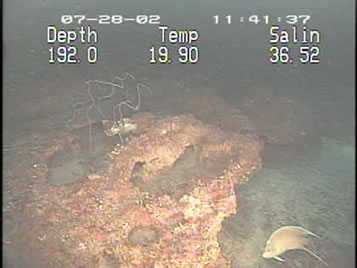 |
Shelf-Edge
Reefs |
 |
| Shelf-edge reefs occur off the Atlantic east coast at depths ranging from 45-70m. They have moderate relief, ranging from 0-5m. The reefs have many features including outcrops, ridges, overhangs, pitting, and faulting (see visual glossary). The Gulf Stream moves (NNE) quickly across these shelf-edge reefs, and its strong currents sweep the bottom clean of sand in many places. These places where the hard rock is exposed are called hardground. When this hardground is kept exposed, communities of invertebrate organisms are able to congregate and grow there, which creates these underwater oases. These communities consist primarily of sponges, soft coral, bryozoa, and crustaceans, as well as many other invertebrates. The sediments found on these shelf-edge reefs are lithogenic (from eroded rock) and biogenic (from biological sources) sands and biogenic rubble. The perspective from which these reefs are viewed is important. From afar, general physical and ecosystem structure are best seen. Getting a closer look at the reef gives a clearer understanding of individual communities that exist on the reef and the individual organisms that make up those communities. These reefs are best understood when both perspectives are taken into account. |
 |
Ph. 843-953-7846 |
Project Oceanica Dept. of Geology & Environmental Geosciences College of Charleston, Charleston, SC 29424 |
Fax 843-953-7850 |